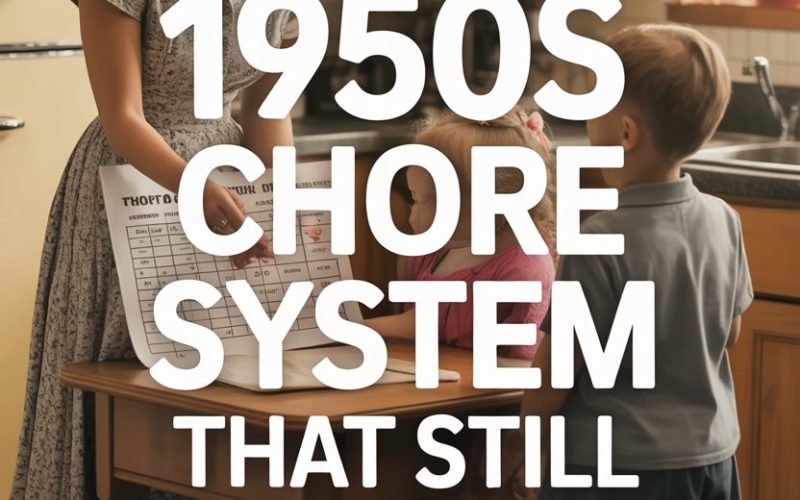If you ever get the sense your household is one rubber glove away from total chaos, you’re not alone. It turns out, there’s something nearly magical about a chore system straight from the days of poodle skirts and Elvis on the radio—one that’s survived Tupperware parties, avocado appliances, and, evidently, TikTok.
Here’s why the 1950s approach to chores still keeps families humming along—and why it might just rescue your Sundays from descending into wild, biscuit-crumbed pandemonium.
Back to Basics: What Was the 1950s Chore System, Anyway?
Before smartphone alarms and colour-coded whiteboards, parents managed a household with nothing more than a wall calendar, a bit of string, and the formidable power of sheer routine.
Chores weren’t “optional enrichment activities.” They were daily life. Kids were expected to help, often because otherwise dinner wouldn’t appear, the dog would eat the carpet, and everyone would run out of clean pants.
Each family member had a set of predictable, age-appropriate jobs. These didn’t rotate on a whim. You knew what was yours, and you did it—no wheel-spinning, no gold-star sticker charts, and definitely no debating who’s “turn” it was.
This consistency is where the magic lives.
Why Consistency (and a Bit of Predictability) Works
Modern parenting sometimes feels like a game of whack-a-mole: one week you’re trying a rewards app, next week you’re making glittery “responsibility jars,” and the only thing you’re consistently picking up is the glitter.
Research shows that routine helps children build responsibility, confidence, and even emotional health.
When children know what’s expected, they’re less likely to push back because the rules feel fair and non-negotiable (Journal of Family Theory and Review). The 1950s system capitalized on this: jobs were assigned (not begged for or traded), and they stayed put for weeks, months, or even years.
You’ll get less complaining simply because…well, it’s Tuesday, and Tuesday always means emptying the bins.
Family Meetings: Yes, They Had Those Too
It’s tempting to imagine Mum just issued orders while Dad read the paper, but even vintage families knew the value of gathering everyone together at the kitchen table.
The classic approach? A short, weekly family “meeting” (though nobody called it that) to check in: Are jobs getting done? Does someone need help? Is there a new baby chick in the coop who can now feed the cat?
This not only built accountability, it gave every child a sense of belonging and agency.
Children knew their contribution mattered. And if you’re worried your own kids will roll their eyes at the idea, tell them they’ll be done in five minutes and can have dibs on the remote. Suddenly, everyone’s invested.
The Secret Sauce: ‘Just Enough’ Parental Oversight
The 1950s system wasn’t about hovering over every dust mote. Parents gave instructions, did the initial demonstration, and then stepped back.
If the job was done badly (or, let’s be honest, “creatively”), the next time Mum would patiently—but firmly—show how to do it properly.
Children weren’t expected to get it perfect right away, but they were expected to improve. This blend of expectation and coaching built competence without constant nagging or micro-management.
It’s the same principle as teaching a child to ride a bike: steady hands, a big push, and—eventually—letting go. (Just, you know, with less risk of scraped knees and more risk of a slightly eccentric sock-drawer arrangement.)
Chore Charts: Retro, Not Ridiculous
A wall chart scrawled in your best “teacher writing” might feel old-fashioned compared to an app, but there’s real power in something visible and public. The 1950s family chore chart was usually simple: each kid’s name, their specific jobs, and a box to tick.
No complicated reward systems, no mystery incentives. The satisfaction of a job finished—and, perhaps, a slice of cake after dinner—was plenty.
Visual reminders help children take ownership and keep everyone honest. If the bins are still overflowing and there’s an empty checkbox next to “Jamie,” there’s no mystery about who’s on deck. (Child Mind Institute)
Stick the chart somewhere everyone can see it. You’ll be shocked at how quickly the “not me” phase disappears.
Age Appropriate, Not Age Aspirational
One of the sneaky strengths of the 1950s system? Assigning jobs based on what kids can do, not what you wish they could.
Tiny hands carry cutlery, not crystal. Tweens scrub, but no one’s expecting them to deep-clean the oven. Teenagers? They’re perfectly capable of handling a washing machine or mowing the lawn—assuming you’re okay with slightly wonky mowing lines.
Matching chores to ability avoids frustration (and shattered heirlooms), and gives kids the satisfaction of mastering tasks. It’s about teaching, not torturing.
You don’t have to get this perfect. If your little one’s “folded” flannels look like they came from Picasso’s laundry basket, celebrate the effort and offer a gentle nudge next time.
Natural Consequences Rule the Day
If a job didn’t get done in the 1950s—say, a child skipped their turn setting the table—there wasn’t a dramatic showdown. The likely outcome? Dinner was delayed and the family sat around looking awkward until the plates arrived.
Natural consequences teach responsibility far more effectively than punishment. If the bins aren’t emptied, everyone sees the result. If socks don’t get sorted, someone runs out midweek.
This isn’t about shaming; it’s about connecting action with outcome. The feedback is immediate and obvious. Before long, your kids might just surprise you by getting it done before you ask.
Rewards That Aren’t Bribes
One of the more charming aspects of the 1950s system is how rewards were built into the fabric of family life. There weren’t elaborate sticker charts or “chores-for-screen-time” negotiations at every turn.
Kids contributed because they were part of the team. The reward? Time together, Saturday morning pancakes, maybe a trip for ice-cream. Chores weren’t transactional—they were communal.
Modern research backs this up: tying chores to family membership, not external rewards, builds self-motivation and a sense of belonging (American Academy of Child & Adolescent Psychiatry). Give your child the gift of knowing their effort matters, not just their ability to rack up points.
Making It Work in Your (Real-Life, 21st Century) Home
You don’t have to throw out your dishwasher or start wearing pearls to put the 1950s system to work. Here’s how to adapt the approach without feeling like you’ve time-travelled straight into “Leave It to Beaver.”
Stay Consistent: Pick chores that truly need doing, assign them clearly, and stick to your guns. If you change it up too often, you’ll spend your energy refereeing squabbles instead of sipping your well-earned cuppa.
Model, Don’t Micromanage: Show your kids how a job’s done, then let them have a real go. Resist the urge to swoop in and “fix” it unless it’s a genuine safety issue (or something involving permanent marker).
Keep It Public (But Positive): Use a chart, a list, even sticky notes—whatever works for your family. Keep it somewhere everyone passes daily, and celebrate effort as much as results.
Don’t Fear Natural Consequences: It’s okay if things go a bit pear-shaped now and then. If your child refuses to clean their room and can’t find their favourite trainers, that’s a life lesson, not a catastrophe.
Make Chores Part of Family Life: Tackle tidying with music blaring, or see who can beat the clock folding laundry. The goal isn’t perfection—it’s pitching in together.
Common Pitfalls—and How to Sidestep Them
Even the best systems get wobbly now and again. If you’re finding things aren’t quite working, check for these classic trip-ups:
Reassigning Too Often: Swapping jobs every week sounds fair, but it’s also a recipe for confusion. Let kids settle in and master their role before switching things up.
Expecting Too Much, Too Soon: If you hand over the car keys (or, you know, the ironing) to your six-year-old, you’re in for trouble. Build up gradually.
Making Chores a Punishment: Chores are a part of belonging, not a penalty for annoying you three times before breakfast. Keep your tone matter-of-fact and neutral.
Confusing Help with Perfection: If your child’s efforts don’t meet your standards, offer praise for what’s right and a bit of gentle correction for what’s not. Progress over perfection, every time.
The Not-So-Secret Bonus: Raising Capable, Confident Kids
The payoff here isn’t just a tidier lounge (though that’s a lovely fringe benefit). Kids who help at home grow into adults who know how to take care of themselves and others.
They feel a sense of pride, competence, and connection—qualities that last long after they’ve outgrown their “chores” and moved on to bigger and better things, like moving out and doing laundry in their own flat (miracles do happen, eventually).
Dust Off That Old-School Magic Tonight
If you’re craving a little less chaos and a little more harmony, give the 1950s chore system a whirl. You don’t need rotary phones or housecoats—just a bit of structure, some patience, and the willingness to let kids pitch in.
Try assigning one or two clear, age-appropriate jobs to each child tonight. Make it consistent. Make it visible. And watch what happens: a little routine, a little laughter, and a whole lot less biscuit-crumbed mayhem.
Time-tested wisdom, right there in your kitchen. Elvis would approve.





